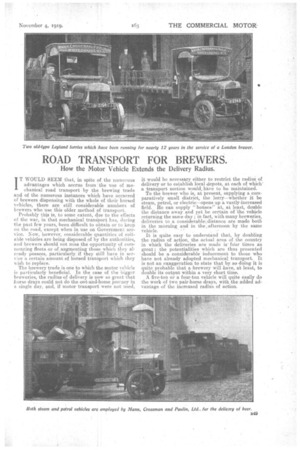ROAD TRANSPORT FOR BREWERS.
Page 21

Page 22

If you've noticed an error in this article please click here to report it so we can fix it.
How the Motor Vehicle Extends the Delivery Radius.
IT WOULD SEEM that, in spite of the numerous advantages which accrue from the use of mechanical road transport by the. brewing trade and of the numerous instances which have occurred of brewers dispensing with the whole of their horsed vehicles, there am still consid.erabls numbers of brewers who use this older method of transport..
Probably this is to some extent, due to the effects of the war, in that mechanical transPort has, during the past few years, been difficult to obtain or to keep on the road, except.when in use on Government service. Now, however, considerable quantities of suitable vehicles are being disposed of by the authorities, and brewers should not miss the opportunity of commencing fleets or of Augmenting those which they already possess, particularly if they still haVe in service a certain amount of horsed transport which they wish to rePlace; The: brewery trade is one to which the motor vehicle is particularly beneficial. In the case of the bigler breweries, the radius of delivery is now so great t iat horse drays coidd not do the out-and-home journey in a single day, and, if Motor transport were not used, it would be. necessary either to restrict the radius of delivery or to establish local depots, at each of which' a transport section would.linve to be maintained. To the brewer who is, at present, .supplying a comparatively small district, the lorry—whether it be steam, petrol, or .electric—opens up a vastly-increased field. He can supply "houses.' at, at least, double the distance .away and yet be certain of 'the vehicle returning the same day ; in fact, with many breweries, deliveries to a considerable distance are made both in the morning and in the:afternoon by the same . , vehicle.
It is quite easy to und.erstand that, by doubling the radius of action, the actual area of. the country in which the deliveries are made is fair times as great ; the potentialities which are thus presented should. be a considera.ble. inducement to those who have not already adopte.d .mechanical transport. It is not an exaggeration to state that by CO doing it is quite probable that a brewery will have, it least, to dottble its output within a very short time.
A five-ton or a four-ton vehicle will quite easily do the work of two pair-h.orse drays, with. the added advantage of the increased radius of action. A satisfactory all-round vehicle for the job is the steam wagon. This, apart from the load which it carries, can also tow a trailer. The loads are heavy, whether they be in the foim of casks or bottles. A considerable number of barrels is difficult to carry, and this is where trailers offer great advantages. At present, however, it is difficult to obtain an adequate number of this type of vehicle, but the four-ton W.D. type, in fair condition, will do the work very efficiently, though it cannot be expected to take its own load and haul a trailer at the same time.
For covering areas within a comparatively short
radius of the brewery, electric vehicles have provedthemselves to be eminently satisfactory. The hat
teries can now be depended upon to have a life of several years and, providing adequate arrangements are made fa; charging, their employment should certainly prove of considerable benefit to brewers ; in fact, some of the big brewery houses, such as Mann, Grossman and Paulin, employ all three types of vehicle.
Dealing with any one type of vehicle, we do not recommend the purchase of a variety of makes. It
is far preferable to commence with a lorry of reliable make and to build up a fleet of similar ones. With a mixed fleet, the difficulties of upkeep are naturally greater.
A brewery employing a considerable fleet of lorries is Hancocks,. of Cardiff. They have some 40 vehicles, both steam and petrol, including Fodens, Albions, Daimlers, Karriers, Napiers, Baileys and PierceArrows, and runs are made as far as Swansea and Ebbw Vale. This company has also established several centres from which to work vehicles; thus they cover a huge tract of country. Their previous fleet consisted entirely of Albions and Daimlers, but the majority of these were commandeered for the war.
The Commercial Brewery Co., Ltd., of Stepney, employ a special low-built Garrett steam wagon, in which the driver has a remarkably clear view of the road. It was briefly described in our issue of June 6th, 1918. Its average mileage is between 250 and 200 per week, and its normal load is 25 barrels of beer, which is equivalent to five tons, but it has carried as many as 28 barrels. We learn that this vehicle is.. doing very satisfactory work.


























